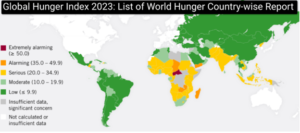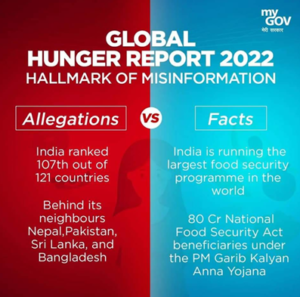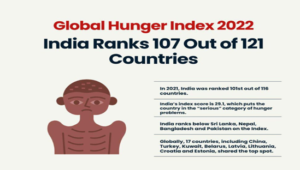Ridding India of food insecurity.
Relevance
- GS Paper- 3: Food Security, Public Distribution System
- Tags: #FoodSecurity #SustainableAgriculture #IndiaEconomy #UPSC #TheHinduEditorial #CurrentAffairs.
Why in the News?
India’s economic growth coexists with rising food price inflation, impacting citizens’ access to healthy diets. This issue necessitates supply-side interventions, evoking lessons from India’s historic Green Revolution, to ensure food affordability and security.
India’s Rapid Economic Growth and Rising Food Prices
While India’s economy is growing quickly, it’s also experiencing rising food prices.
- This increase in food prices started getting faster in 2019 and has kept going up in most years.
- In July this year, the yearly increase in prices went over 11%, the highest in ten years.
- This high and ongoing food price increase could make it hard for some people to afford nutritious food, leading to potential difficulties in getting enough nutrition.
Alarming Evidence of Widespread Inability to Afford Nutritious Food in India
Recent findings from the Food and Agriculture Organization (FAO) reveal a distressing reality in India’s food security landscape.
- As of 2021, an estimated 74% of the population, roughly one billion individuals out of a total population of 1.4 billion, cannot access a healthy diet due to financial constraints.
- This data underscores a grave concern, emphasizing the growing struggle of Indian households to finance their basic nutritional needs.
- Moreover, similar studies conducted within India confirm this troubling trend, shedding light on the urgent need for targeted interventions to address this pressing issue.
Economic Struggles in Mumbai Reflect Worsening Food Affordability Crisis
A recent study unveiled on August 30, 2023, concerning the cost of food in Mumbai between 2018 and 2023 paints a shocking picture of the challenges faced by the city’s residents.
- The study reveals that during this period, the cost of preparing a thaali at home surged by a shocking 65%.
- In sharp contrast, the average wages of manual workers only increased by 38%, while salaried workers saw a modest 28% rise.
- This alarming discrepancy implies a significant erosion of purchasing power among Mumbai’s populace, inevitably affecting food consumption patterns.
- This decline in affordability aligns with the worrying increase in anaemia prevalence, primarily driven by nutrient deficiencies, as indicated in the latest National Family Health Survey conducted from 2019 to 2021.
- Shockingly, over 50% of adult women were found to be anaemic.
- This highlights the credibility of the Food and Agriculture Organization’s (FAO) findings, which suggest that over half of India’s population cannot access a healthy diet.
- Even if we hypothetically reduce the FAO’s estimates by 100%, we are still left with a shocking 500 million individuals facing this dire predicament, a population larger than that of any country in the world, except China.
The most crucial objective of economic policy at the moment is to guarantee that Indians have access to a nutritious food.
- In this situation, macroeconomic policy has failed to control inflation as expected.
- Since the inflation rate has been consistently higher than the objective for the past four years, the Reserve Bank of India has failed in its mission.
- Its “inflation targeting” strategy, which reduces production as inflation rates increase, accomplishes little to control supply-side inflation in food prices.
- It must be stated that central banks are unable to resolve this issue in any reasonable amount of time.
- By increasing the yield on land, supply-side intervention is required to guarantee that food is produced at a constant price.
The significance of the Green Revolution
Due to its role in engineering the Green Revolution in the 1960s, India has extensive knowledge in this field, but it is not being utilized.
- The government took steps to increase the supply of food when there was a severe food shortage due to two consecutive droughts.
- Farmers were given high-yielding crops, inexpensive financing, and guaranteed prices through purchase.
- This was a stunning success, India stopped relying on food imports in a short period of time.
- The most important thing that helped India become self-reliant during the Cold War was the Green Revolution.
- While Western experts often praise the United States for sending a person to the moon, India’s achievement of the Green Revolution was even more crucial.
- India was very poor and had to feed a huge population.
- The Green Revolution, which improved agricultural methods and crop yields, was a massive accomplishment that ensured food for many people.
- This was a remarkable feat, especially considering India’s challenging circumstances.
Learning from Past Mistakes in India’s Agriculture
- Looking back, we can see some mistakes in the past, like using too many chemical fertilizers because of subsidies, which harmed the soil.
- We also relied too much on fixed crop prices, causing inflation, and mainly focused on cereals, ignoring the importance of pulses as a protein source.
- Instead of dwelling on these errors, we should fix them now.
Lowering Food Production Costs Urgently
- We need to focus on reducing the cost of producing food while reflecting on the success of the first Green Revolution, which made India self-sufficient in food but overlooked production costs.
- Now, we require a second agricultural revolution.
- To control rising food prices, we must act on multiple fronts with a sense of urgency.
- Current policies such as fixed procurement prices, cash transfers, the Public Distribution System, and bank lending rules are not enough.
- We need strategies to increase farm yields to at least stabilize, if not lower, production costs.
- This calls for improved farming practices, research, and better support systems.
Boosting India’s Farming Productivity
- India’s crop yield is lower than East Asia’s, indicating room for growth.
- We must expand irrigation, remove land leasing restrictions, speed up research, and revive agricultural extension services to enhance productivity.
Initiatives to work on
Certainly, let’s delve into these proposals
- Improving Irrigation: Despite increased spending on irrigation, the area benefiting from it hasn’t grown as expected. We need to investigate the reasons behind this, whether it’s due to inefficiencies or funds diversion, and fix them. Adequate irrigation is vital for consistent crop yields.
- Land Leasing Reforms: The division of small land holdings limits opportunities for productive investments. Allowing easier land leasing can help consolidate and modernize farming practices, making it more efficient and profitable.
- Revitalizing Agricultural Research: India’s public research institutes used to be a driving force in agriculture during the 1960s. We must re-energize these institutes to innovate and develop better farming methods, crops, and technologies to meet modern challenges.
- Rebuilding Agricultural Extension Services: The disappearance of extension services has left a gap in knowledge sharing. We should resurrect these services, making them accessible to farmers again, so they can benefit from the latest practices and techniques.
These initiatives should be coordinated into a program aimed at significantly increasing protein production, as India currently faces a severe deficiency in this crucial nutrient.
Strengthening State Role in Agricultural Transformation
States play a pivotal role in these proposed agricultural improvements.
- States played a vital role in the successful adoption of new agricultural technologies in the 1960s.
- To address today’s challenges effectively, this cooperation must be revived, with the central government and states working together in a spirit of cooperative federalism.
- Additionally, it’s important to assess whether states are actively contributing to agricultural productivity instead of solely relying on central food allocations for their Public Distribution Systems.
- Collaboration and shared responsibility between the central and state governments are essential to drive agricultural progress and ensure food security for the entire nation.
Pragmatic Approach for Agricultural Progress
- To truly make a difference, both the central and state governments need to adopt a non-ideological approach.
- The first Green Revolution, led by Prime Minister Indira Gandhi, is a noteworthy example.
- She chose a capitalist approach to achieve food self-sufficiency, even if it clashed with her socialist image.
- This strategy significantly reduced poverty and benefited the poor.
Now, as we strive to ensure all Indians have access to a nutritious diet, we must be open to all strategies that align with ecological sustainability. Ideological rigidity should not limit our options when it comes to securing the well-being of our people and the environment.
Source: The Hindu
Mains Question
How can cooperative federalism between the central and state governments be leveraged to address India’s agricultural challenges.






